Comprehensive Report on Managing Energy Resources and Regulations
VerifiedAdded on 2021/04/17
|11
|2887
|282
Report
AI Summary
This report delves into the critical aspects of managing energy resources and regulations, focusing on the UK context. It explores demand-side management (DSM) strategies, emphasizing the importance of sustainable energy practices in light of increasing global energy demands. The report examines demand-side response (DSR) as an intelligent approach to energy usage, highlighting its impact on electricity prices and carbon footprints. It also discusses distributed generation (DG) through alternative power sources like solar panels and batteries, addressing its benefits and implementation barriers. Furthermore, the report analyzes demand reduction strategies, including the barriers to implementation such as lack of financial incentives, and the need for public awareness and business responsibility. The report concludes by emphasizing the necessity of a collective effort from the entire population to address the impending energy crisis and promote sustainable energy practices.
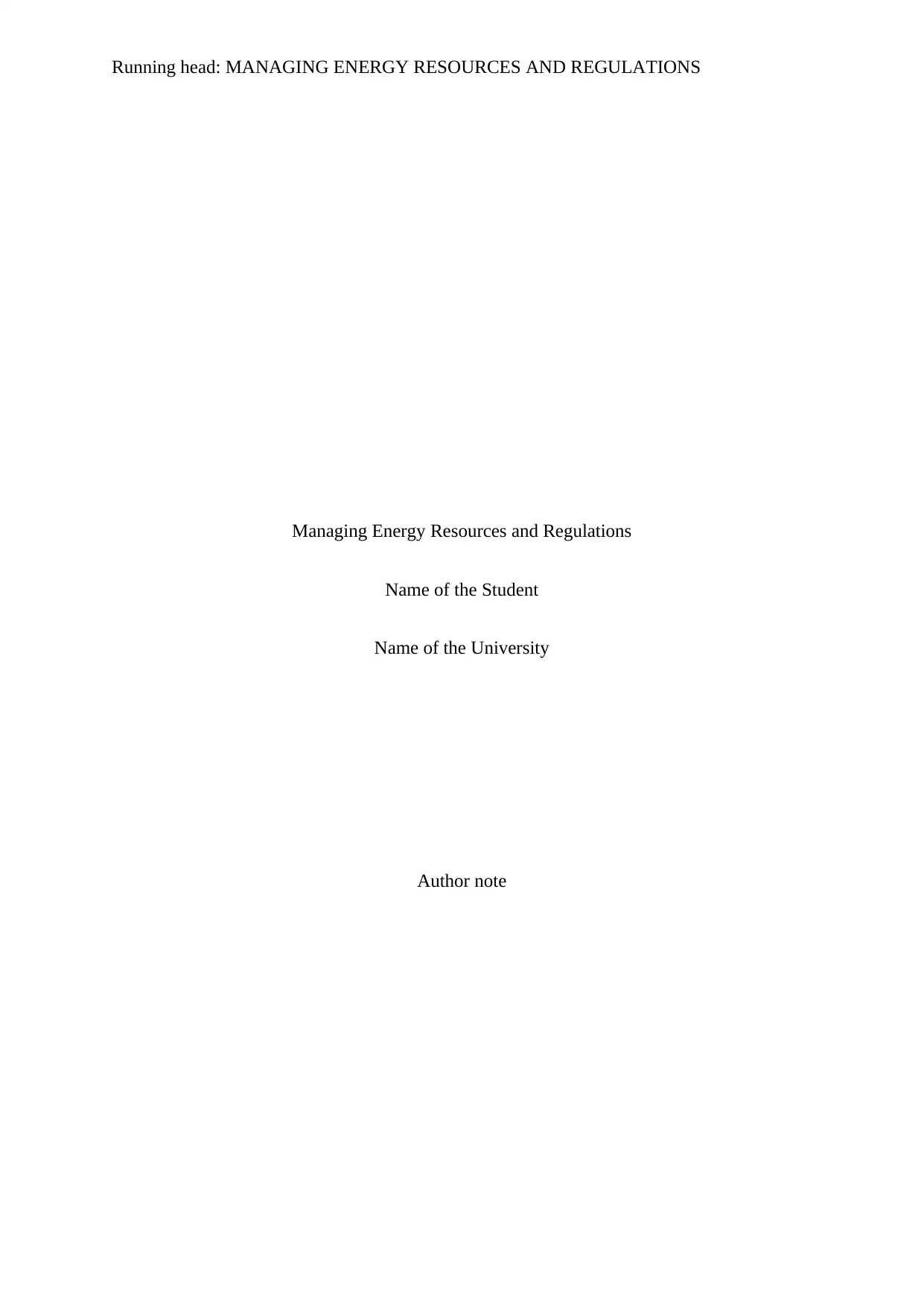
Running head: MANAGING ENERGY RESOURCES AND REGULATIONS
Managing Energy Resources and Regulations
Name of the Student
Name of the University
Author note
Managing Energy Resources and Regulations
Name of the Student
Name of the University
Author note
Paraphrase This Document
Need a fresh take? Get an instant paraphrase of this document with our AI Paraphraser
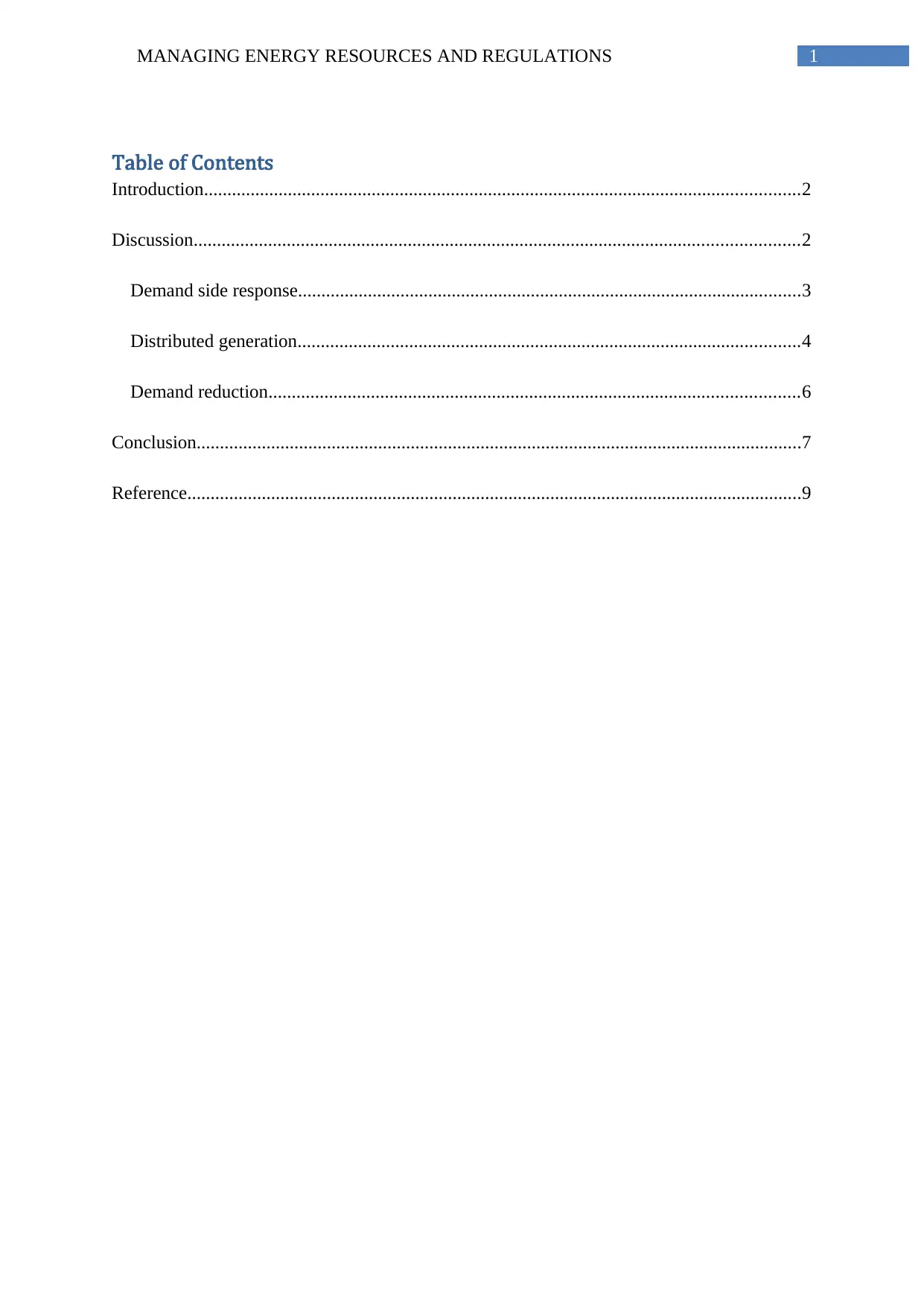
1MANAGING ENERGY RESOURCES AND REGULATIONS
Table of Contents
Introduction................................................................................................................................2
Discussion..................................................................................................................................2
Demand side response............................................................................................................3
Distributed generation............................................................................................................4
Demand reduction..................................................................................................................6
Conclusion..................................................................................................................................7
Reference....................................................................................................................................9
Table of Contents
Introduction................................................................................................................................2
Discussion..................................................................................................................................2
Demand side response............................................................................................................3
Distributed generation............................................................................................................4
Demand reduction..................................................................................................................6
Conclusion..................................................................................................................................7
Reference....................................................................................................................................9
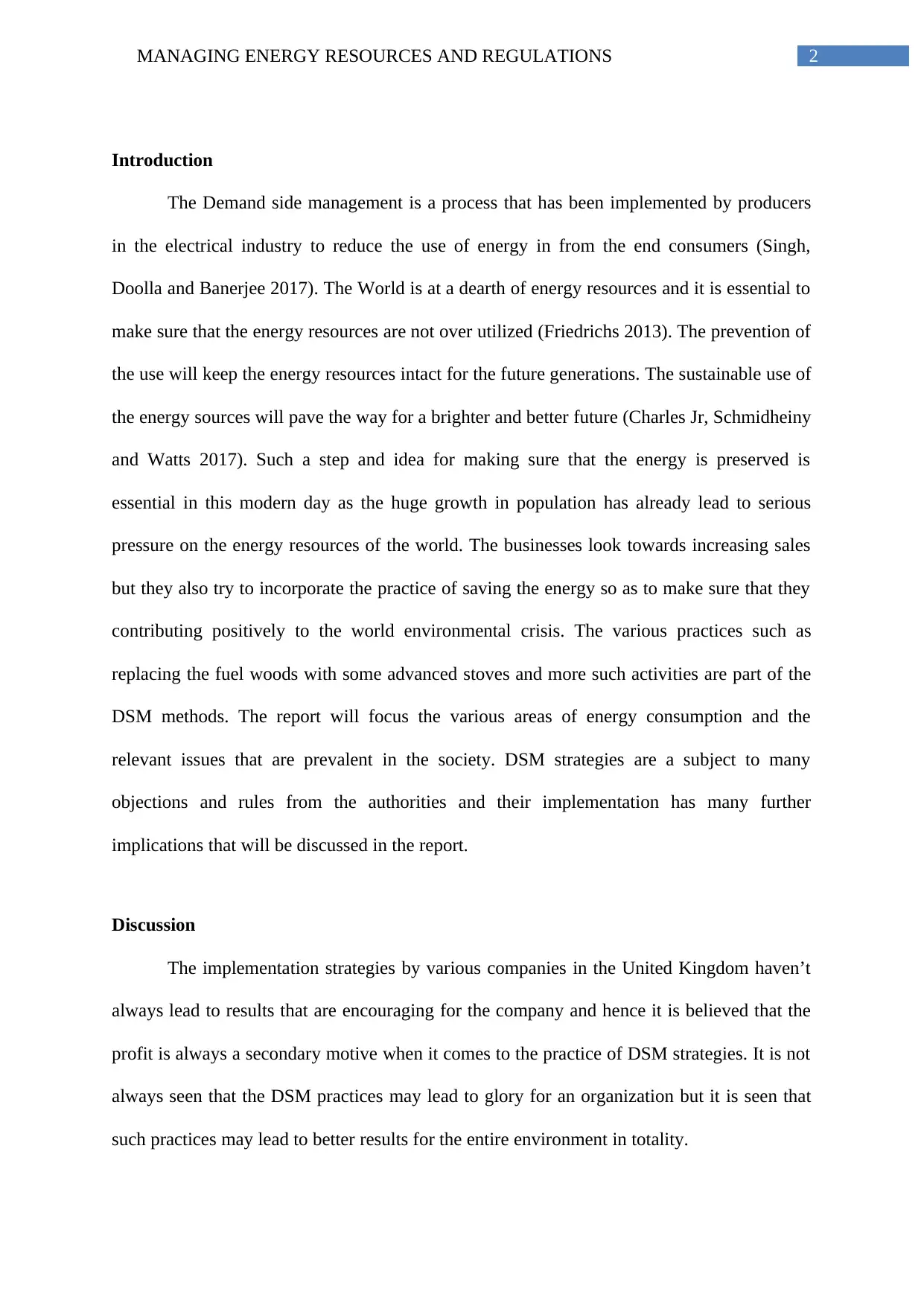
2MANAGING ENERGY RESOURCES AND REGULATIONS
Introduction
The Demand side management is a process that has been implemented by producers
in the electrical industry to reduce the use of energy in from the end consumers (Singh,
Doolla and Banerjee 2017). The World is at a dearth of energy resources and it is essential to
make sure that the energy resources are not over utilized (Friedrichs 2013). The prevention of
the use will keep the energy resources intact for the future generations. The sustainable use of
the energy sources will pave the way for a brighter and better future (Charles Jr, Schmidheiny
and Watts 2017). Such a step and idea for making sure that the energy is preserved is
essential in this modern day as the huge growth in population has already lead to serious
pressure on the energy resources of the world. The businesses look towards increasing sales
but they also try to incorporate the practice of saving the energy so as to make sure that they
contributing positively to the world environmental crisis. The various practices such as
replacing the fuel woods with some advanced stoves and more such activities are part of the
DSM methods. The report will focus the various areas of energy consumption and the
relevant issues that are prevalent in the society. DSM strategies are a subject to many
objections and rules from the authorities and their implementation has many further
implications that will be discussed in the report.
Discussion
The implementation strategies by various companies in the United Kingdom haven’t
always lead to results that are encouraging for the company and hence it is believed that the
profit is always a secondary motive when it comes to the practice of DSM strategies. It is not
always seen that the DSM practices may lead to glory for an organization but it is seen that
such practices may lead to better results for the entire environment in totality.
Introduction
The Demand side management is a process that has been implemented by producers
in the electrical industry to reduce the use of energy in from the end consumers (Singh,
Doolla and Banerjee 2017). The World is at a dearth of energy resources and it is essential to
make sure that the energy resources are not over utilized (Friedrichs 2013). The prevention of
the use will keep the energy resources intact for the future generations. The sustainable use of
the energy sources will pave the way for a brighter and better future (Charles Jr, Schmidheiny
and Watts 2017). Such a step and idea for making sure that the energy is preserved is
essential in this modern day as the huge growth in population has already lead to serious
pressure on the energy resources of the world. The businesses look towards increasing sales
but they also try to incorporate the practice of saving the energy so as to make sure that they
contributing positively to the world environmental crisis. The various practices such as
replacing the fuel woods with some advanced stoves and more such activities are part of the
DSM methods. The report will focus the various areas of energy consumption and the
relevant issues that are prevalent in the society. DSM strategies are a subject to many
objections and rules from the authorities and their implementation has many further
implications that will be discussed in the report.
Discussion
The implementation strategies by various companies in the United Kingdom haven’t
always lead to results that are encouraging for the company and hence it is believed that the
profit is always a secondary motive when it comes to the practice of DSM strategies. It is not
always seen that the DSM practices may lead to glory for an organization but it is seen that
such practices may lead to better results for the entire environment in totality.
⊘ This is a preview!⊘
Do you want full access?
Subscribe today to unlock all pages.

Trusted by 1+ million students worldwide
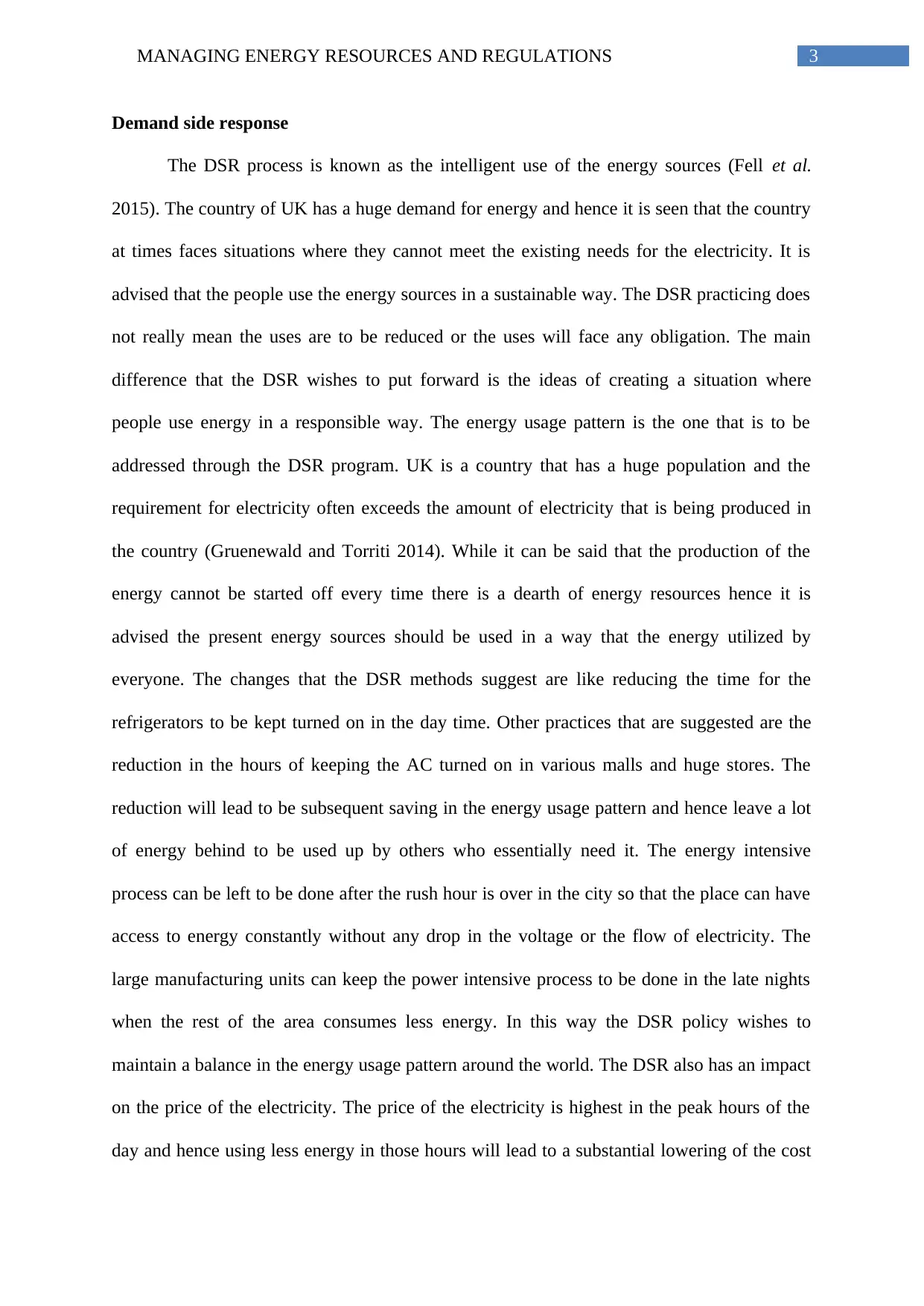
3MANAGING ENERGY RESOURCES AND REGULATIONS
Demand side response
The DSR process is known as the intelligent use of the energy sources (Fell et al.
2015). The country of UK has a huge demand for energy and hence it is seen that the country
at times faces situations where they cannot meet the existing needs for the electricity. It is
advised that the people use the energy sources in a sustainable way. The DSR practicing does
not really mean the uses are to be reduced or the uses will face any obligation. The main
difference that the DSR wishes to put forward is the ideas of creating a situation where
people use energy in a responsible way. The energy usage pattern is the one that is to be
addressed through the DSR program. UK is a country that has a huge population and the
requirement for electricity often exceeds the amount of electricity that is being produced in
the country (Gruenewald and Torriti 2014). While it can be said that the production of the
energy cannot be started off every time there is a dearth of energy resources hence it is
advised the present energy sources should be used in a way that the energy utilized by
everyone. The changes that the DSR methods suggest are like reducing the time for the
refrigerators to be kept turned on in the day time. Other practices that are suggested are the
reduction in the hours of keeping the AC turned on in various malls and huge stores. The
reduction will lead to be subsequent saving in the energy usage pattern and hence leave a lot
of energy behind to be used up by others who essentially need it. The energy intensive
process can be left to be done after the rush hour is over in the city so that the place can have
access to energy constantly without any drop in the voltage or the flow of electricity. The
large manufacturing units can keep the power intensive process to be done in the late nights
when the rest of the area consumes less energy. In this way the DSR policy wishes to
maintain a balance in the energy usage pattern around the world. The DSR also has an impact
on the price of the electricity. The price of the electricity is highest in the peak hours of the
day and hence using less energy in those hours will lead to a substantial lowering of the cost
Demand side response
The DSR process is known as the intelligent use of the energy sources (Fell et al.
2015). The country of UK has a huge demand for energy and hence it is seen that the country
at times faces situations where they cannot meet the existing needs for the electricity. It is
advised that the people use the energy sources in a sustainable way. The DSR practicing does
not really mean the uses are to be reduced or the uses will face any obligation. The main
difference that the DSR wishes to put forward is the ideas of creating a situation where
people use energy in a responsible way. The energy usage pattern is the one that is to be
addressed through the DSR program. UK is a country that has a huge population and the
requirement for electricity often exceeds the amount of electricity that is being produced in
the country (Gruenewald and Torriti 2014). While it can be said that the production of the
energy cannot be started off every time there is a dearth of energy resources hence it is
advised the present energy sources should be used in a way that the energy utilized by
everyone. The changes that the DSR methods suggest are like reducing the time for the
refrigerators to be kept turned on in the day time. Other practices that are suggested are the
reduction in the hours of keeping the AC turned on in various malls and huge stores. The
reduction will lead to be subsequent saving in the energy usage pattern and hence leave a lot
of energy behind to be used up by others who essentially need it. The energy intensive
process can be left to be done after the rush hour is over in the city so that the place can have
access to energy constantly without any drop in the voltage or the flow of electricity. The
large manufacturing units can keep the power intensive process to be done in the late nights
when the rest of the area consumes less energy. In this way the DSR policy wishes to
maintain a balance in the energy usage pattern around the world. The DSR also has an impact
on the price of the electricity. The price of the electricity is highest in the peak hours of the
day and hence using less energy in those hours will lead to a substantial lowering of the cost
Paraphrase This Document
Need a fresh take? Get an instant paraphrase of this document with our AI Paraphraser
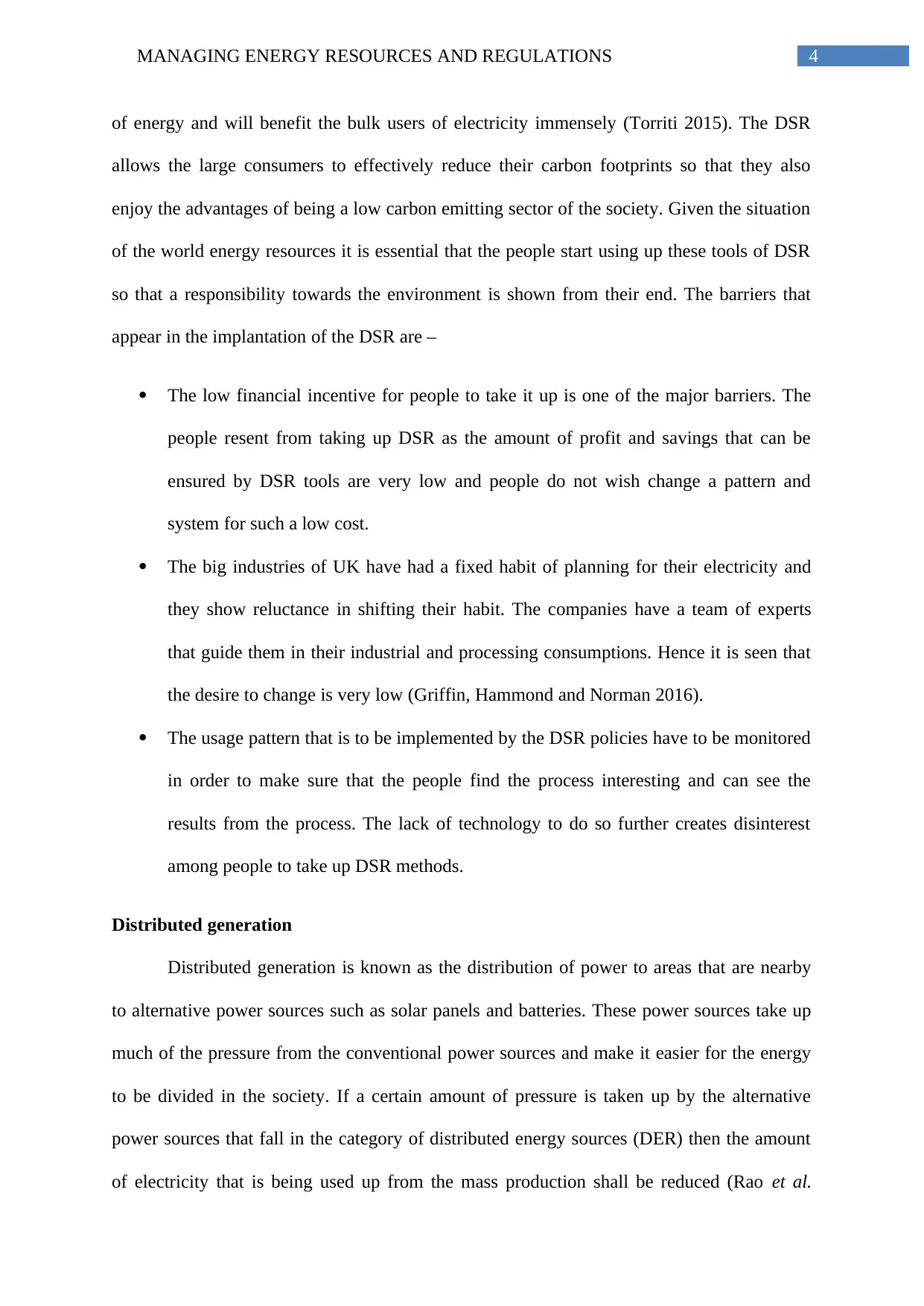
4MANAGING ENERGY RESOURCES AND REGULATIONS
of energy and will benefit the bulk users of electricity immensely (Torriti 2015). The DSR
allows the large consumers to effectively reduce their carbon footprints so that they also
enjoy the advantages of being a low carbon emitting sector of the society. Given the situation
of the world energy resources it is essential that the people start using up these tools of DSR
so that a responsibility towards the environment is shown from their end. The barriers that
appear in the implantation of the DSR are –
The low financial incentive for people to take it up is one of the major barriers. The
people resent from taking up DSR as the amount of profit and savings that can be
ensured by DSR tools are very low and people do not wish change a pattern and
system for such a low cost.
The big industries of UK have had a fixed habit of planning for their electricity and
they show reluctance in shifting their habit. The companies have a team of experts
that guide them in their industrial and processing consumptions. Hence it is seen that
the desire to change is very low (Griffin, Hammond and Norman 2016).
The usage pattern that is to be implemented by the DSR policies have to be monitored
in order to make sure that the people find the process interesting and can see the
results from the process. The lack of technology to do so further creates disinterest
among people to take up DSR methods.
Distributed generation
Distributed generation is known as the distribution of power to areas that are nearby
to alternative power sources such as solar panels and batteries. These power sources take up
much of the pressure from the conventional power sources and make it easier for the energy
to be divided in the society. If a certain amount of pressure is taken up by the alternative
power sources that fall in the category of distributed energy sources (DER) then the amount
of electricity that is being used up from the mass production shall be reduced (Rao et al.
of energy and will benefit the bulk users of electricity immensely (Torriti 2015). The DSR
allows the large consumers to effectively reduce their carbon footprints so that they also
enjoy the advantages of being a low carbon emitting sector of the society. Given the situation
of the world energy resources it is essential that the people start using up these tools of DSR
so that a responsibility towards the environment is shown from their end. The barriers that
appear in the implantation of the DSR are –
The low financial incentive for people to take it up is one of the major barriers. The
people resent from taking up DSR as the amount of profit and savings that can be
ensured by DSR tools are very low and people do not wish change a pattern and
system for such a low cost.
The big industries of UK have had a fixed habit of planning for their electricity and
they show reluctance in shifting their habit. The companies have a team of experts
that guide them in their industrial and processing consumptions. Hence it is seen that
the desire to change is very low (Griffin, Hammond and Norman 2016).
The usage pattern that is to be implemented by the DSR policies have to be monitored
in order to make sure that the people find the process interesting and can see the
results from the process. The lack of technology to do so further creates disinterest
among people to take up DSR methods.
Distributed generation
Distributed generation is known as the distribution of power to areas that are nearby
to alternative power sources such as solar panels and batteries. These power sources take up
much of the pressure from the conventional power sources and make it easier for the energy
to be divided in the society. If a certain amount of pressure is taken up by the alternative
power sources that fall in the category of distributed energy sources (DER) then the amount
of electricity that is being used up from the mass production shall be reduced (Rao et al.
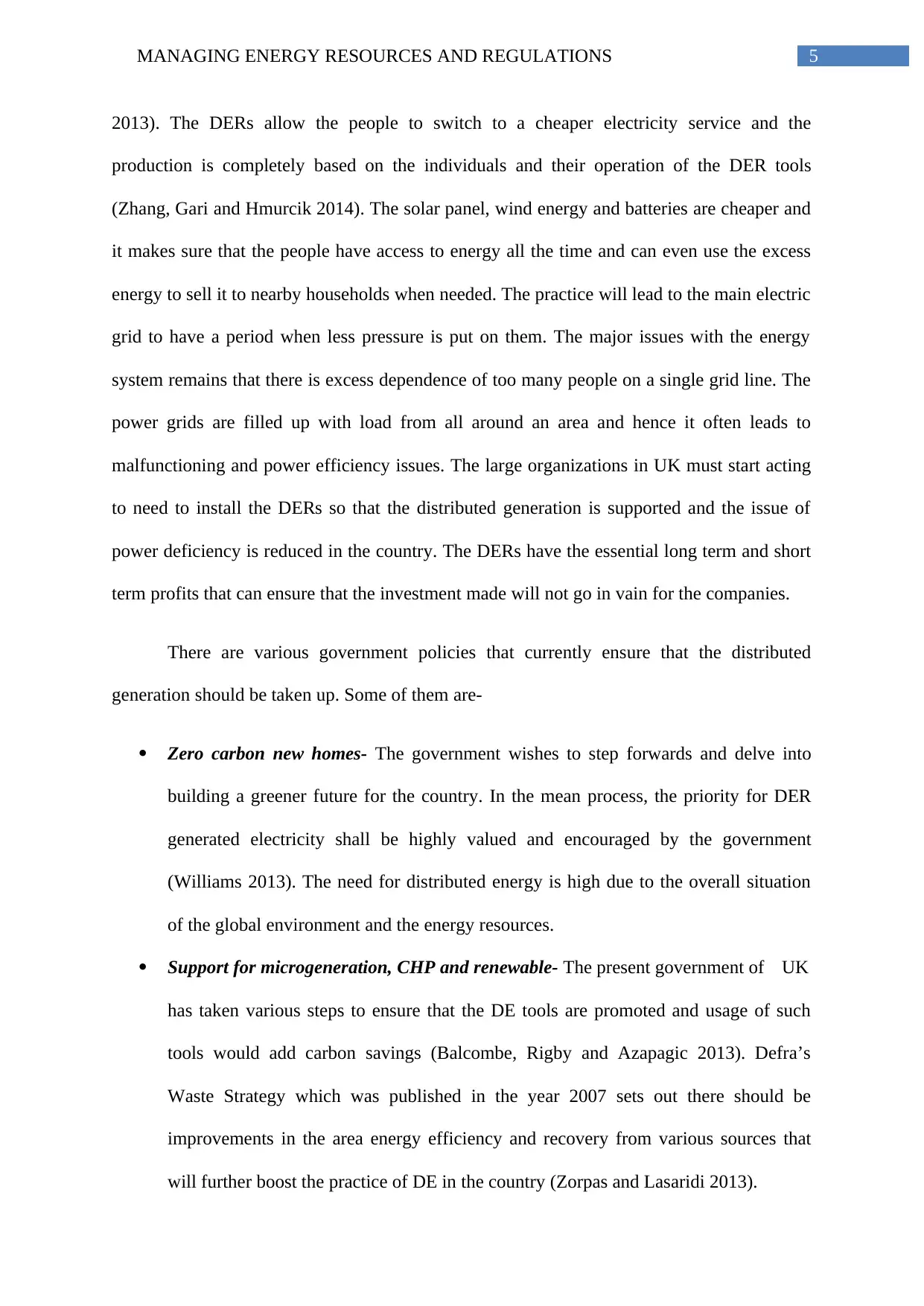
5MANAGING ENERGY RESOURCES AND REGULATIONS
2013). The DERs allow the people to switch to a cheaper electricity service and the
production is completely based on the individuals and their operation of the DER tools
(Zhang, Gari and Hmurcik 2014). The solar panel, wind energy and batteries are cheaper and
it makes sure that the people have access to energy all the time and can even use the excess
energy to sell it to nearby households when needed. The practice will lead to the main electric
grid to have a period when less pressure is put on them. The major issues with the energy
system remains that there is excess dependence of too many people on a single grid line. The
power grids are filled up with load from all around an area and hence it often leads to
malfunctioning and power efficiency issues. The large organizations in UK must start acting
to need to install the DERs so that the distributed generation is supported and the issue of
power deficiency is reduced in the country. The DERs have the essential long term and short
term profits that can ensure that the investment made will not go in vain for the companies.
There are various government policies that currently ensure that the distributed
generation should be taken up. Some of them are-
Zero carbon new homes- The government wishes to step forwards and delve into
building a greener future for the country. In the mean process, the priority for DER
generated electricity shall be highly valued and encouraged by the government
(Williams 2013). The need for distributed energy is high due to the overall situation
of the global environment and the energy resources.
Support for microgeneration, CHP and renewable- The present government of UK
has taken various steps to ensure that the DE tools are promoted and usage of such
tools would add carbon savings (Balcombe, Rigby and Azapagic 2013). Defra’s
Waste Strategy which was published in the year 2007 sets out there should be
improvements in the area energy efficiency and recovery from various sources that
will further boost the practice of DE in the country (Zorpas and Lasaridi 2013).
2013). The DERs allow the people to switch to a cheaper electricity service and the
production is completely based on the individuals and their operation of the DER tools
(Zhang, Gari and Hmurcik 2014). The solar panel, wind energy and batteries are cheaper and
it makes sure that the people have access to energy all the time and can even use the excess
energy to sell it to nearby households when needed. The practice will lead to the main electric
grid to have a period when less pressure is put on them. The major issues with the energy
system remains that there is excess dependence of too many people on a single grid line. The
power grids are filled up with load from all around an area and hence it often leads to
malfunctioning and power efficiency issues. The large organizations in UK must start acting
to need to install the DERs so that the distributed generation is supported and the issue of
power deficiency is reduced in the country. The DERs have the essential long term and short
term profits that can ensure that the investment made will not go in vain for the companies.
There are various government policies that currently ensure that the distributed
generation should be taken up. Some of them are-
Zero carbon new homes- The government wishes to step forwards and delve into
building a greener future for the country. In the mean process, the priority for DER
generated electricity shall be highly valued and encouraged by the government
(Williams 2013). The need for distributed energy is high due to the overall situation
of the global environment and the energy resources.
Support for microgeneration, CHP and renewable- The present government of UK
has taken various steps to ensure that the DE tools are promoted and usage of such
tools would add carbon savings (Balcombe, Rigby and Azapagic 2013). Defra’s
Waste Strategy which was published in the year 2007 sets out there should be
improvements in the area energy efficiency and recovery from various sources that
will further boost the practice of DE in the country (Zorpas and Lasaridi 2013).
⊘ This is a preview!⊘
Do you want full access?
Subscribe today to unlock all pages.

Trusted by 1+ million students worldwide
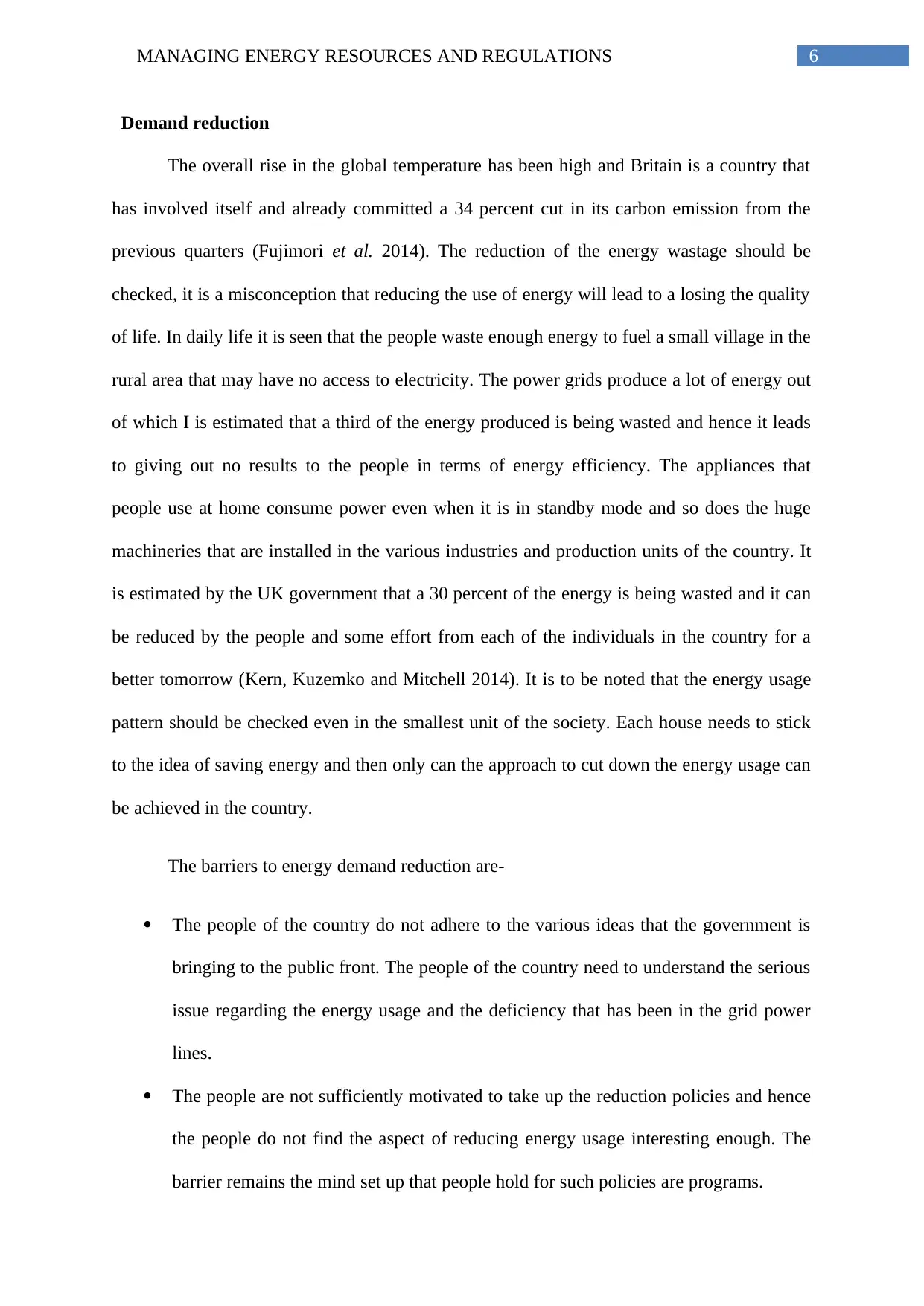
6MANAGING ENERGY RESOURCES AND REGULATIONS
Demand reduction
The overall rise in the global temperature has been high and Britain is a country that
has involved itself and already committed a 34 percent cut in its carbon emission from the
previous quarters (Fujimori et al. 2014). The reduction of the energy wastage should be
checked, it is a misconception that reducing the use of energy will lead to a losing the quality
of life. In daily life it is seen that the people waste enough energy to fuel a small village in the
rural area that may have no access to electricity. The power grids produce a lot of energy out
of which I is estimated that a third of the energy produced is being wasted and hence it leads
to giving out no results to the people in terms of energy efficiency. The appliances that
people use at home consume power even when it is in standby mode and so does the huge
machineries that are installed in the various industries and production units of the country. It
is estimated by the UK government that a 30 percent of the energy is being wasted and it can
be reduced by the people and some effort from each of the individuals in the country for a
better tomorrow (Kern, Kuzemko and Mitchell 2014). It is to be noted that the energy usage
pattern should be checked even in the smallest unit of the society. Each house needs to stick
to the idea of saving energy and then only can the approach to cut down the energy usage can
be achieved in the country.
The barriers to energy demand reduction are-
The people of the country do not adhere to the various ideas that the government is
bringing to the public front. The people of the country need to understand the serious
issue regarding the energy usage and the deficiency that has been in the grid power
lines.
The people are not sufficiently motivated to take up the reduction policies and hence
the people do not find the aspect of reducing energy usage interesting enough. The
barrier remains the mind set up that people hold for such policies are programs.
Demand reduction
The overall rise in the global temperature has been high and Britain is a country that
has involved itself and already committed a 34 percent cut in its carbon emission from the
previous quarters (Fujimori et al. 2014). The reduction of the energy wastage should be
checked, it is a misconception that reducing the use of energy will lead to a losing the quality
of life. In daily life it is seen that the people waste enough energy to fuel a small village in the
rural area that may have no access to electricity. The power grids produce a lot of energy out
of which I is estimated that a third of the energy produced is being wasted and hence it leads
to giving out no results to the people in terms of energy efficiency. The appliances that
people use at home consume power even when it is in standby mode and so does the huge
machineries that are installed in the various industries and production units of the country. It
is estimated by the UK government that a 30 percent of the energy is being wasted and it can
be reduced by the people and some effort from each of the individuals in the country for a
better tomorrow (Kern, Kuzemko and Mitchell 2014). It is to be noted that the energy usage
pattern should be checked even in the smallest unit of the society. Each house needs to stick
to the idea of saving energy and then only can the approach to cut down the energy usage can
be achieved in the country.
The barriers to energy demand reduction are-
The people of the country do not adhere to the various ideas that the government is
bringing to the public front. The people of the country need to understand the serious
issue regarding the energy usage and the deficiency that has been in the grid power
lines.
The people are not sufficiently motivated to take up the reduction policies and hence
the people do not find the aspect of reducing energy usage interesting enough. The
barrier remains the mind set up that people hold for such policies are programs.
Paraphrase This Document
Need a fresh take? Get an instant paraphrase of this document with our AI Paraphraser
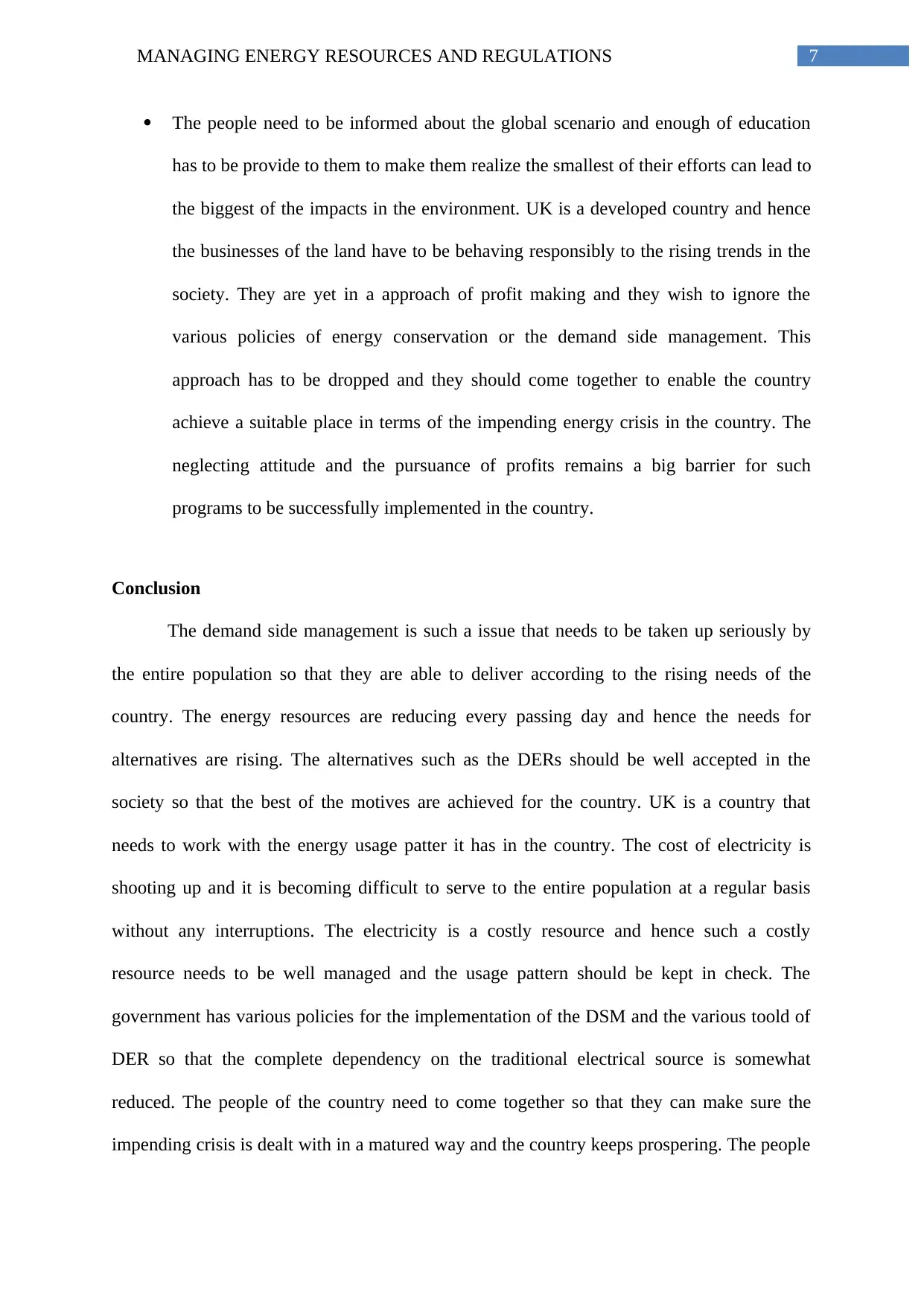
7MANAGING ENERGY RESOURCES AND REGULATIONS
The people need to be informed about the global scenario and enough of education
has to be provide to them to make them realize the smallest of their efforts can lead to
the biggest of the impacts in the environment. UK is a developed country and hence
the businesses of the land have to be behaving responsibly to the rising trends in the
society. They are yet in a approach of profit making and they wish to ignore the
various policies of energy conservation or the demand side management. This
approach has to be dropped and they should come together to enable the country
achieve a suitable place in terms of the impending energy crisis in the country. The
neglecting attitude and the pursuance of profits remains a big barrier for such
programs to be successfully implemented in the country.
Conclusion
The demand side management is such a issue that needs to be taken up seriously by
the entire population so that they are able to deliver according to the rising needs of the
country. The energy resources are reducing every passing day and hence the needs for
alternatives are rising. The alternatives such as the DERs should be well accepted in the
society so that the best of the motives are achieved for the country. UK is a country that
needs to work with the energy usage patter it has in the country. The cost of electricity is
shooting up and it is becoming difficult to serve to the entire population at a regular basis
without any interruptions. The electricity is a costly resource and hence such a costly
resource needs to be well managed and the usage pattern should be kept in check. The
government has various policies for the implementation of the DSM and the various toold of
DER so that the complete dependency on the traditional electrical source is somewhat
reduced. The people of the country need to come together so that they can make sure the
impending crisis is dealt with in a matured way and the country keeps prospering. The people
The people need to be informed about the global scenario and enough of education
has to be provide to them to make them realize the smallest of their efforts can lead to
the biggest of the impacts in the environment. UK is a developed country and hence
the businesses of the land have to be behaving responsibly to the rising trends in the
society. They are yet in a approach of profit making and they wish to ignore the
various policies of energy conservation or the demand side management. This
approach has to be dropped and they should come together to enable the country
achieve a suitable place in terms of the impending energy crisis in the country. The
neglecting attitude and the pursuance of profits remains a big barrier for such
programs to be successfully implemented in the country.
Conclusion
The demand side management is such a issue that needs to be taken up seriously by
the entire population so that they are able to deliver according to the rising needs of the
country. The energy resources are reducing every passing day and hence the needs for
alternatives are rising. The alternatives such as the DERs should be well accepted in the
society so that the best of the motives are achieved for the country. UK is a country that
needs to work with the energy usage patter it has in the country. The cost of electricity is
shooting up and it is becoming difficult to serve to the entire population at a regular basis
without any interruptions. The electricity is a costly resource and hence such a costly
resource needs to be well managed and the usage pattern should be kept in check. The
government has various policies for the implementation of the DSM and the various toold of
DER so that the complete dependency on the traditional electrical source is somewhat
reduced. The people of the country need to come together so that they can make sure the
impending crisis is dealt with in a matured way and the country keeps prospering. The people
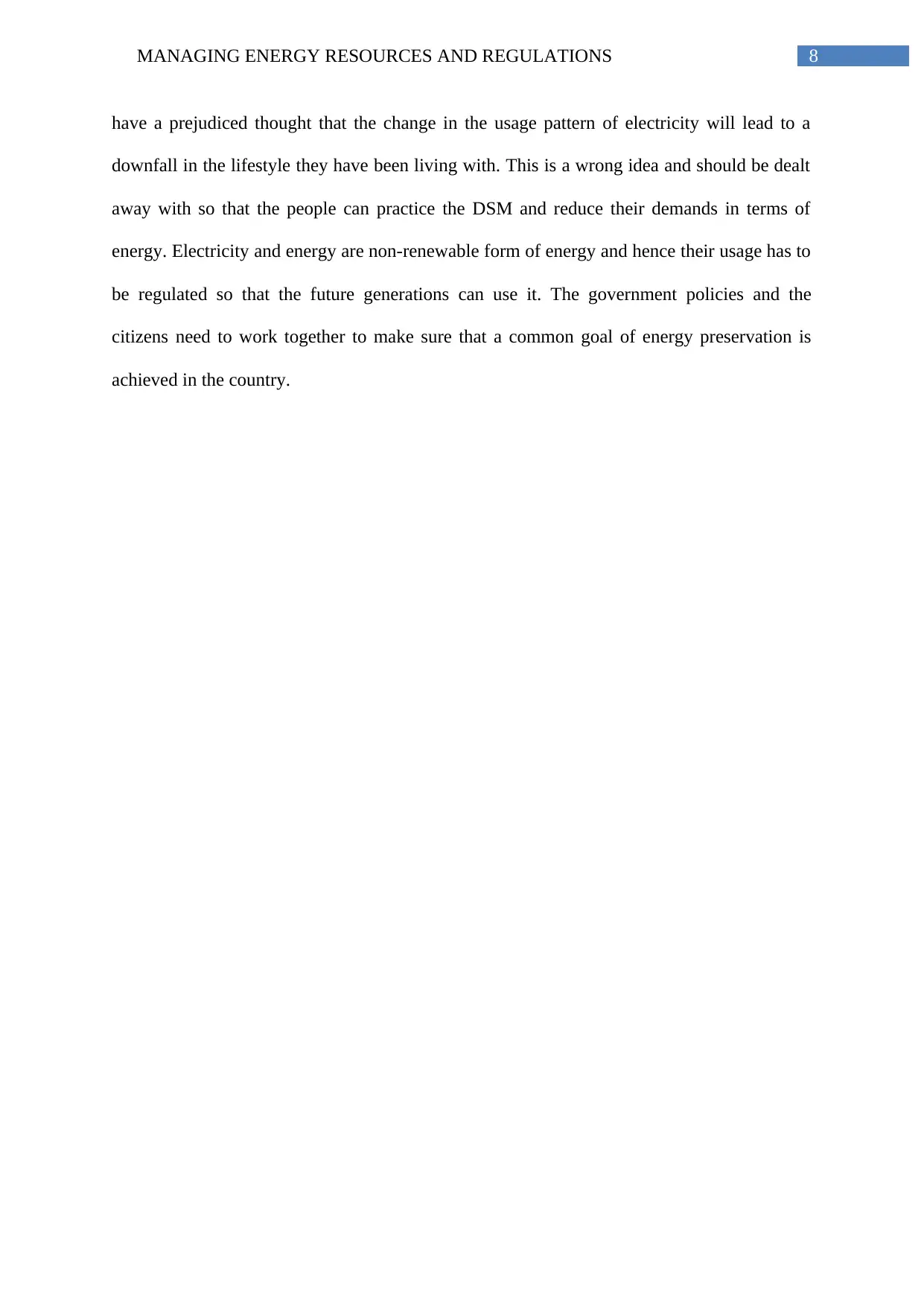
8MANAGING ENERGY RESOURCES AND REGULATIONS
have a prejudiced thought that the change in the usage pattern of electricity will lead to a
downfall in the lifestyle they have been living with. This is a wrong idea and should be dealt
away with so that the people can practice the DSM and reduce their demands in terms of
energy. Electricity and energy are non-renewable form of energy and hence their usage has to
be regulated so that the future generations can use it. The government policies and the
citizens need to work together to make sure that a common goal of energy preservation is
achieved in the country.
have a prejudiced thought that the change in the usage pattern of electricity will lead to a
downfall in the lifestyle they have been living with. This is a wrong idea and should be dealt
away with so that the people can practice the DSM and reduce their demands in terms of
energy. Electricity and energy are non-renewable form of energy and hence their usage has to
be regulated so that the future generations can use it. The government policies and the
citizens need to work together to make sure that a common goal of energy preservation is
achieved in the country.
⊘ This is a preview!⊘
Do you want full access?
Subscribe today to unlock all pages.

Trusted by 1+ million students worldwide
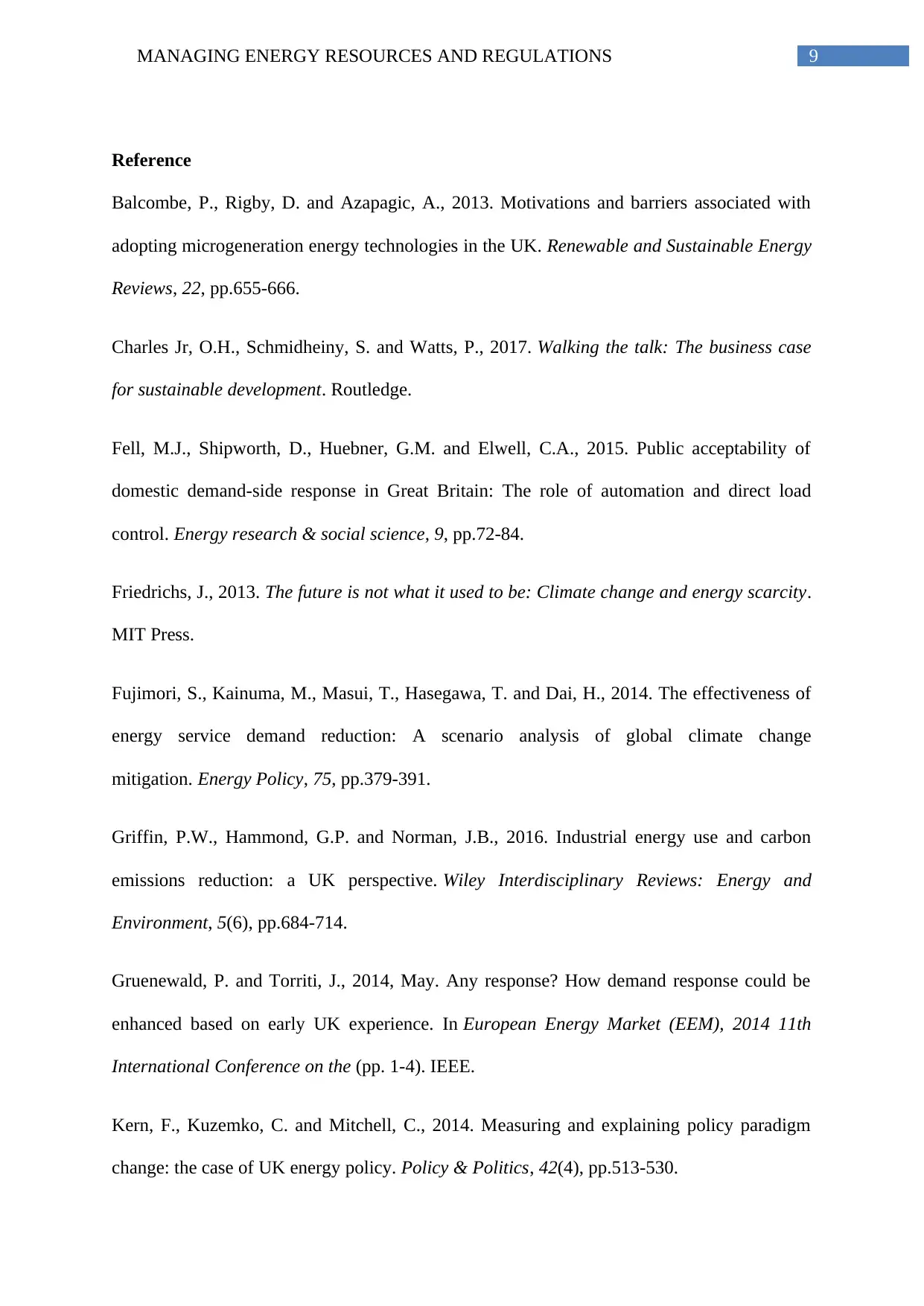
9MANAGING ENERGY RESOURCES AND REGULATIONS
Reference
Balcombe, P., Rigby, D. and Azapagic, A., 2013. Motivations and barriers associated with
adopting microgeneration energy technologies in the UK. Renewable and Sustainable Energy
Reviews, 22, pp.655-666.
Charles Jr, O.H., Schmidheiny, S. and Watts, P., 2017. Walking the talk: The business case
for sustainable development. Routledge.
Fell, M.J., Shipworth, D., Huebner, G.M. and Elwell, C.A., 2015. Public acceptability of
domestic demand-side response in Great Britain: The role of automation and direct load
control. Energy research & social science, 9, pp.72-84.
Friedrichs, J., 2013. The future is not what it used to be: Climate change and energy scarcity.
MIT Press.
Fujimori, S., Kainuma, M., Masui, T., Hasegawa, T. and Dai, H., 2014. The effectiveness of
energy service demand reduction: A scenario analysis of global climate change
mitigation. Energy Policy, 75, pp.379-391.
Griffin, P.W., Hammond, G.P. and Norman, J.B., 2016. Industrial energy use and carbon
emissions reduction: a UK perspective. Wiley Interdisciplinary Reviews: Energy and
Environment, 5(6), pp.684-714.
Gruenewald, P. and Torriti, J., 2014, May. Any response? How demand response could be
enhanced based on early UK experience. In European Energy Market (EEM), 2014 11th
International Conference on the (pp. 1-4). IEEE.
Kern, F., Kuzemko, C. and Mitchell, C., 2014. Measuring and explaining policy paradigm
change: the case of UK energy policy. Policy & Politics, 42(4), pp.513-530.
Reference
Balcombe, P., Rigby, D. and Azapagic, A., 2013. Motivations and barriers associated with
adopting microgeneration energy technologies in the UK. Renewable and Sustainable Energy
Reviews, 22, pp.655-666.
Charles Jr, O.H., Schmidheiny, S. and Watts, P., 2017. Walking the talk: The business case
for sustainable development. Routledge.
Fell, M.J., Shipworth, D., Huebner, G.M. and Elwell, C.A., 2015. Public acceptability of
domestic demand-side response in Great Britain: The role of automation and direct load
control. Energy research & social science, 9, pp.72-84.
Friedrichs, J., 2013. The future is not what it used to be: Climate change and energy scarcity.
MIT Press.
Fujimori, S., Kainuma, M., Masui, T., Hasegawa, T. and Dai, H., 2014. The effectiveness of
energy service demand reduction: A scenario analysis of global climate change
mitigation. Energy Policy, 75, pp.379-391.
Griffin, P.W., Hammond, G.P. and Norman, J.B., 2016. Industrial energy use and carbon
emissions reduction: a UK perspective. Wiley Interdisciplinary Reviews: Energy and
Environment, 5(6), pp.684-714.
Gruenewald, P. and Torriti, J., 2014, May. Any response? How demand response could be
enhanced based on early UK experience. In European Energy Market (EEM), 2014 11th
International Conference on the (pp. 1-4). IEEE.
Kern, F., Kuzemko, C. and Mitchell, C., 2014. Measuring and explaining policy paradigm
change: the case of UK energy policy. Policy & Politics, 42(4), pp.513-530.
Paraphrase This Document
Need a fresh take? Get an instant paraphrase of this document with our AI Paraphraser
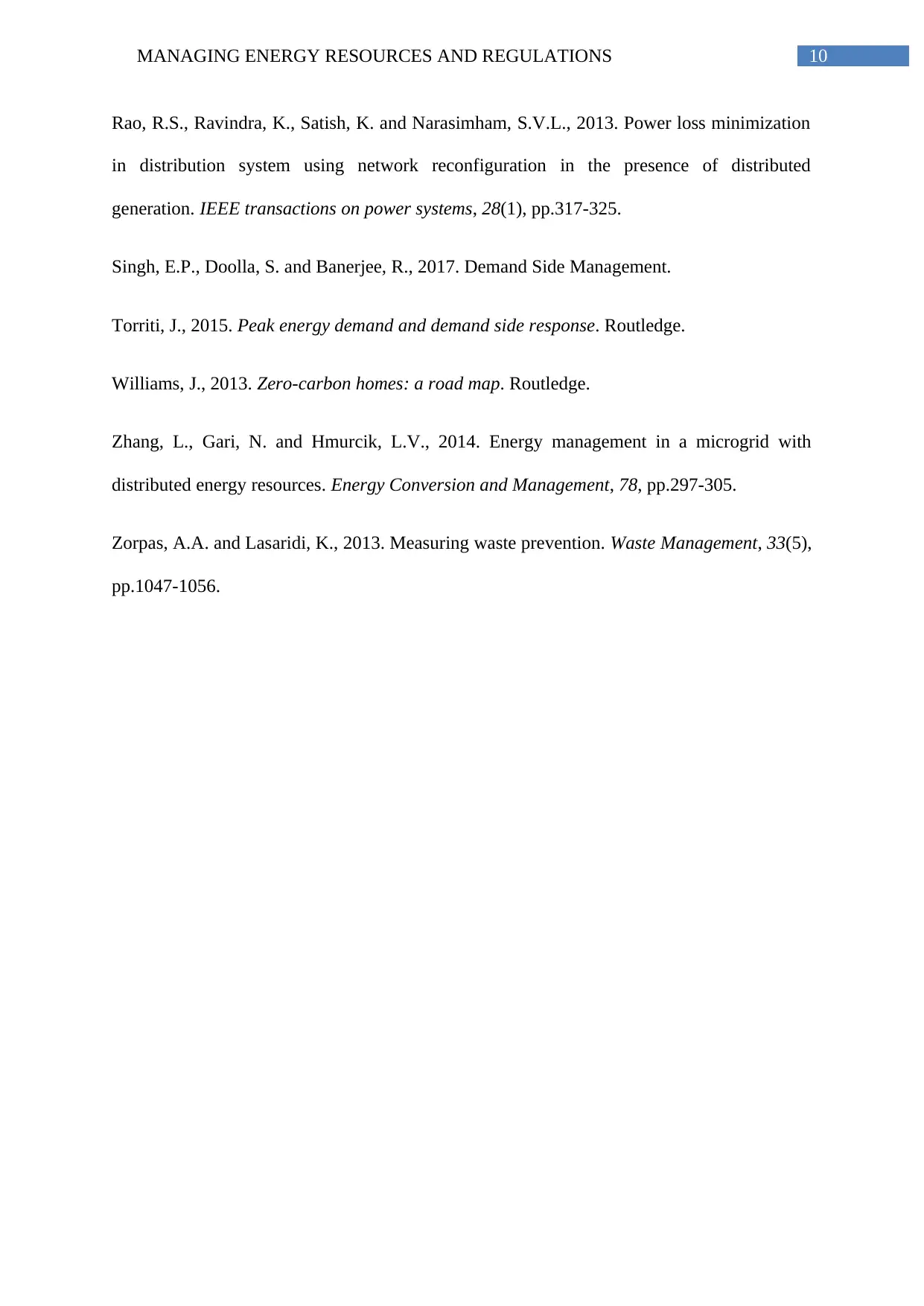
10MANAGING ENERGY RESOURCES AND REGULATIONS
Rao, R.S., Ravindra, K., Satish, K. and Narasimham, S.V.L., 2013. Power loss minimization
in distribution system using network reconfiguration in the presence of distributed
generation. IEEE transactions on power systems, 28(1), pp.317-325.
Singh, E.P., Doolla, S. and Banerjee, R., 2017. Demand Side Management.
Torriti, J., 2015. Peak energy demand and demand side response. Routledge.
Williams, J., 2013. Zero-carbon homes: a road map. Routledge.
Zhang, L., Gari, N. and Hmurcik, L.V., 2014. Energy management in a microgrid with
distributed energy resources. Energy Conversion and Management, 78, pp.297-305.
Zorpas, A.A. and Lasaridi, K., 2013. Measuring waste prevention. Waste Management, 33(5),
pp.1047-1056.
Rao, R.S., Ravindra, K., Satish, K. and Narasimham, S.V.L., 2013. Power loss minimization
in distribution system using network reconfiguration in the presence of distributed
generation. IEEE transactions on power systems, 28(1), pp.317-325.
Singh, E.P., Doolla, S. and Banerjee, R., 2017. Demand Side Management.
Torriti, J., 2015. Peak energy demand and demand side response. Routledge.
Williams, J., 2013. Zero-carbon homes: a road map. Routledge.
Zhang, L., Gari, N. and Hmurcik, L.V., 2014. Energy management in a microgrid with
distributed energy resources. Energy Conversion and Management, 78, pp.297-305.
Zorpas, A.A. and Lasaridi, K., 2013. Measuring waste prevention. Waste Management, 33(5),
pp.1047-1056.
1 out of 11
Related Documents
Your All-in-One AI-Powered Toolkit for Academic Success.
+13062052269
info@desklib.com
Available 24*7 on WhatsApp / Email
![[object Object]](/_next/static/media/star-bottom.7253800d.svg)
Unlock your academic potential
Copyright © 2020–2025 A2Z Services. All Rights Reserved. Developed and managed by ZUCOL.




